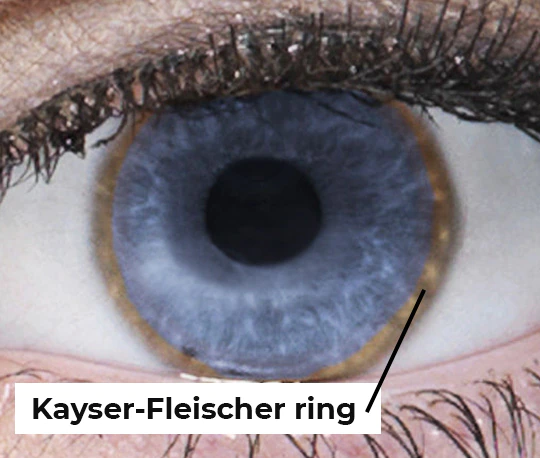Ac(Cu)mulation - Hepatolenticular Degeneration
- medicorumsacrament
- Jan 18, 2022
- 4 min read
Also known as Wilson's disease and lenticular progressive degeneration, is a rare but serious disease in which copper metal accumulates in your vital organs such as the liver, brain and eyes. Up till now, Wilson’s disease has been diagnosed in people between the ages of 5 to 35 however experts say that it can be present in people younger or older than that.
Many may not know that in adults aged 20 and older, average daily intakes of copper from food are between 1,100 - 1,400 mcg. Copper is an essential element for your body as it helps in the development of healthy nerves, bones, collagen and the skin pigment melanin. The excess copper is secreted by the liver through a fluid called bile however people living with Wilson’s disease do not excrete this copper as their body stores it in tissues of organs. This disease is progressive and can be fatal if left untreated.
Causes
Wilson's disease is inherited as an autosomal recessive trait, you need to receive 1 copy of the defective gene (as it is a recessive trait) from each parent, only one copy won’t affect you however you may still pass it onto your children(making you a carrier parent).
The chance of 2 carrier parents to have a child with Wilson’s disease is 25%, it is best to get genetically mapped if you suspect carrying this gene. Although estimates vary, it is believed that Wilson’s disease occurs in approximately one in 30,000 to 40,000 people worldwide. Approximately one in 90 people may be carriers of the disease gene.
Researchers have determined that Wilson’s disease is caused by disruption or changes (mutations) of the ATP7B gene, which plays an important role in the movement of excess copper from the liver to the bile to eventually be excreted from the body through the intestines. More than 300 different mutations of the ATP7B gene have been identified. (“Wilson Disease - NORD”)
Symptoms
The damage from this disease starts at the tender age of six however the symptoms only show up during the teenage years or in their twenties.
Jaundice - yellowing of the skin and eye
Kayser-Fleischer rings - a golden brown discolouration of the eye
Oedema and ascites - swelling of the legs and abdomen due to fluid build-up
oesophagal varices - abnormal blood vessels in the oesophagus that may bleed (problems talking or swallowing )
fatigue
Possible Complications
Cirrhosis: Scarring of the liver. As the liver tries to repair the damage made by the copper accumulation (the liver is the only organ that can regenerate) scar tissue forms, making functioning more difficult.
Neurological problems such as memory and motor function problems: an excess of copper can be toxic to the body and often even after treatment these neurological problems persist.
Kidney problems such as the development of kidney stones: The kidneys are damaged when a person suffers from Wilson’s disease leading to kidney stones and too many amino acids being secreted through the urine due to this.
Blood problems: the liver is responsible for filtering blood that enters through the hepatic portal vein. Due to the damage of the liver, it can lead to issues such as anaemia and/or jaundice due to hemolysis (destruction of red blood cells causing haemoglobin to leak out)
Liver failure: This can occur suddenly (acute liver failure), or it can develop slowly over years. A liver transplant might be a treatment option.
Diagnosis
Wilson’s disease is a tricky one to diagnose due to its symptoms that can easily be mistaken for another disease. Although only about 2,000-3,000 cases have been diagnosed in the United States, it’s estimated that there may actually be 9,000 people affected by Wilson’s disease. (“Wilson Disease - NORD”)
Wilson’s disease is diagnosed through careful clinical evaluation. Many tests can be done but the most common is a slit-lamp examination of the eyes that reveal the presence of Kayser-Fleischer rings; tests of the fluid portion of the blood (serum) that demonstrate low levels of ceruloplasmin, a copper protein; and tests that reveal abnormally high levels of copper excreted in the urine. In some cases, liver biopsies are also conducted to check for copper levels however this is a more invasive method.
Therapies
For Wilson’s disease therapies are aimed at reducing and maintaining normal copper levels in the long term. There are 3 medications prescribed normally: chelating agents, zinc salts and tetrathiomolybdate.
Chelating agents are chemicals that react with metal ions to form stable, water-soluble metal complexes. When it reacts with the copper, it will dissolve it in the plasma go to the kidneys to be excreted. Some of the chelating agents are D-penicillamine and trientine.
Zinc salts prevent the gut from absorbing copper from the diet. Zinc acetate (Galzin) is the most used medicine.
Lastly, tetrathiomolybdate prevents absorbing copper and binds up toxic copper in the blood making it non-toxic
Treatments slightly vary according to the patient’s symptoms, for example in mild-moderate liver failure patients, trientine and zinc can be used to treat for 4-6 months, and then zinc or trientine can be used for maintenance.
In another instance affected asymptomatic individuals or individuals initially treated with chelators are treated with zinc acetate to prevent copper absorption. Due to its limited side effects, zinc therapy is often preferred on children and pregnant women. For some patients intolerant of zinc due to gastric irritation, maintenance therapy with trientine is suitable.
Wilson’s disease is extremely rare and difficult to diagnose. Genetic mapping is the best option to know if you have it or are a carrier. It is important to know if you’re a carrier as it will help you and your children to tackle any future problems whether it be Wilson’s disease or any other genetically inherited illness.
Written by: Sakshi Deshpande
Edited by: Svasti Tewari
Citations





Comments